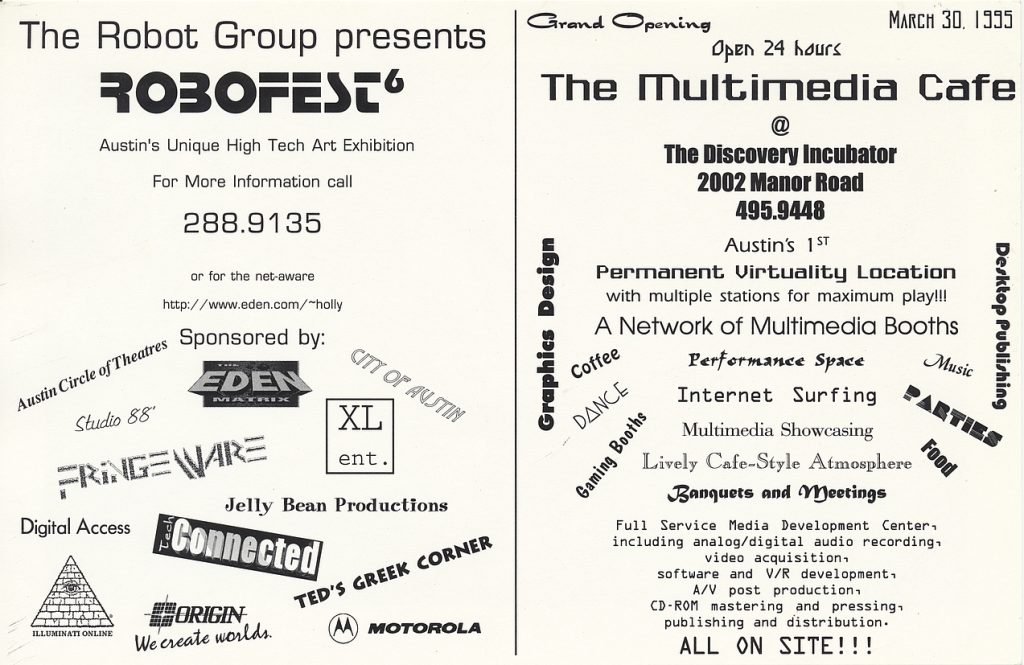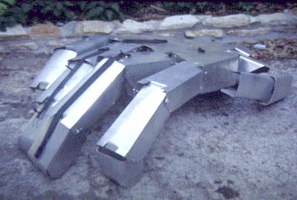RoboFest 6 was held April 1st and 2nd, 1995 at the Austin City Coliseum

Keeping Austin weird before weird was cool
RoboFest 6 was held April 1st and 2nd, 1995 at the Austin City Coliseum

The Robot Group, in a collaborative effort, produced an installation entitled “Berzerkwerks” which was on display during August of 1991, at the Austin Children’s Museum.
The work consisted of various computerized kinetic sculptures interactively-controlled by a central computer through a video input device. The observer’s moving image was dynamically captured by a video digitizer, and mixed with computer graphics. Interaction of the captured image with the computer graphic objects controlled the behavior of the sculptures. The combined image was then projected onto a large screen.
In addition, several of The Robot Group members participate in an annual Berzerkwerks outing now called Jump Start.
The program is taken to local elementary schools in at-risk areas. These shows are very popular with the kids. By encouraging these youth to be interested in science at a young age, we hope to help them stay interested in school.
Who knows? The next Einstein could be right in our backyard.
In between RoboFest 1 and RoboFest 2, The Robot Group hosted the Cyberspace Convention on 04-06 May 1990, at Discovery Hall, our second consecutive record-breaking event at that venue.
This event showcased the Sense8 WorldToolKit virtual reality SDK, developed by Eric Gullichsen. Gullichsen, former project leader for Autodesk’s Cyberspace Project, is the founder of the Sense8 Corporation.
He came to the convention from California to demonstrate his software and to instruct users on the Sense8 system.
In organizing the convention, The Robot Group attracted the attention of a group of scientists who were attending an international conference on cyberspace at the University of Texas at Austin.
The Robot Group thrilled the crowd of scientists, artists, and curious children with demonstrations of their most famous devices as well as new works like the Bipedal Ornithopter, a 12-foot long airship propelled by mechanical legs and insect-like wings.
Also on display was a Space Shuttle Simulator developed by Austin’s Kealing Junior High (now, Kealing Middle School) students with assistance from The Robot Group.

Also on display was a Space Shuttle Simulator developed by Austin’s Kealing Junior High (now, Kealing Middle School) students with assistance from The Robot Group.
This mock-up featured a large robotic manipulator-arm, constructed by the students from salvage. The students used the simulator to “fly” missions and accomplish tasks such as rescuing satellites and performing experiments. During these simulated missions, the ground crews communicated with the flight crew via computer terminals and video cameras.
Other exhibits included the Venus Project, the Crawling Hand, Styro Varmint, and Varmint.

The Cyberspace Convention was a celebration of the cyber-art aesthetic. Live music and performance art entertained the museum visitors and convention-goers who were waiting their turn to experience virtual reality of the robotic kind.
[Mike is seeking additional images for the Bipedal Ornithopter, the Crawling Hand Robot, the Keeling Space Shuttle Simulator, Varmint, and the Venus Project.
Let him know if you have knowledge of any other projects that were exhibited at the Cyberspace Convention.]
The background material for this page is derived from an archived page on the Internet Archive Wayback Machine. Some links may have been added, removed, or updated.
In addition, confirmation of the exact dates was provided by determining the dates of a concurrent First Conference on Cyberspace sponsored by the School of Architecture at the University of Texas – Austin.
On November 5th, 1989, the first public exhibition of The Robot Group’s work was held at Discovery Hall, a hands-on science museum in Austin (no longer in existence).
The event was called RoboFest and it broke all previous attendance records at the museum. We are sorry that Discovery Hall did not survive as an entity. This happens to a lot of non-profit groups; however, the spirit of Discovery Hall lives on in other organizations like ours that continue to push the science education envelope.
A large and curious crowd collected, eager to see The Robot Group’s imaginative creations which included :
[1] Brooks Coleman has suggested that the Centipede evolved into the Mechanical Pit Bull.
The background material for this page is derived from an archived page on the Internet Archive Wayback Machine. Some links may have been added, removed, or updated.